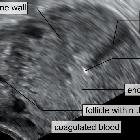decidual cyst
A pseudogestational sac, also known as a pseudosac or intra-cavitary fluid, is the concept that a small amount of intrauterine fluid in the setting of a positive pregnancy test and abdominal pain could be erroneously interpreted as a true gestational sac in ectopic pregnancy.
The sign was originally reported before the use of transvaginal ultrasound imaging and caution should be exercised if considering diagnosing a pseudogestational sac with modern ultrasound equipment. In a woman with a positive beta-hCG, any intrauterine sac-like fluid collection seen on ultrasound is highly likely to be a gestational sac .
Radiographic features
Ultrasound
- generally irregularly-shaped with pointed edges and/or filled with debris, sometimes referred to as 'beaking'
- centrally located in the endometrial cavity, rather than eccentrically located within the endometrium
- displaces the anterior and posterior endometrial cavity surfaces
- does not demonstrate a yolk sac
- a double decidual layer is compatible with intrauterine pregnancy, but lack of this sign is not specific for pseudogestational sac
- may be surrounded by a thick decidual layer
It should be distinguished from an intradecidual sign, which is also a sign of early pregnancy.
The idea of beta-hCG "discriminatory levels" has also fallen out of favor since this sign was formulated. Caution should be exercised in making a diagnosis of pseudogestational sac based on a beta-HCG level at which a yolk sac is expected to be seen as this has been shown to be unreliable. Therapy should not be initiated in a haemodynamically-stable woman on the basis of a single beta-hCG level.
Differential diagnosis
- decidual cyst
- normal intrauterine pregnancy
- anembryonic pregnancy
- incomplete miscarriage
- blood products
Siehe auch:
- early pregnancy
- gestational sac
- Extrauteringravidität
- Dottersack
- double decidual sign
- intra-decidual sign
und weiter:


 Assoziationen und Differentialdiagnosen zu
Assoziationen und Differentialdiagnosen zu 
